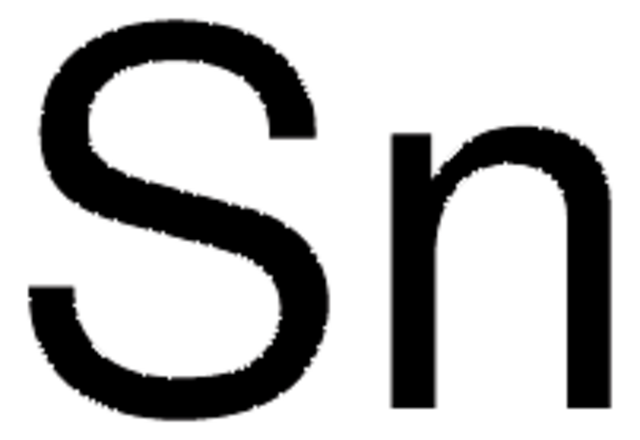244651
Tin(IV) oxide
−325 mesh, 99.9% trace metals basis
Synonyme(s) :
Stannic oxide
Se connecterpour consulter vos tarifs contractuels et ceux de votre entreprise/organisme
About This Item
Formule linéaire :
SnO2
Numéro CAS:
Poids moléculaire :
150.71
Numéro CE :
Numéro MDL:
Code UNSPSC :
12352303
ID de substance PubChem :
Nomenclature NACRES :
NA.23
Produits recommandés
Niveau de qualité
Pureté
99.9% trace metals basis
Forme
powder
Taille des particules
−325 mesh
Densité
6.95 g/mL at 25 °C (lit.)
Application(s)
battery manufacturing
Chaîne SMILES
O=[Sn]=O
InChI
1S/2O.Sn
Clé InChI
XOLBLPGZBRYERU-UHFFFAOYSA-N
Vous recherchez des produits similaires ? Visite Guide de comparaison des produits
Catégories apparentées
Description générale
Tin(IV) oxide (SnO2) is an n-type wide band gap semiconductor with high transmittance at nearIR and visible region. It is scratch resistant and chemically inert.
Application
Tin(IV) oxide has been used to prepare thin films of TiO2-doped SnO2 oxide nanocomposites.
It can be used as astarting material to prepare niobium and zinc-doped titanium-tin-oxidesolid-solution ceramics, which are applicable in the field of electronicdevices.
It can be used as astarting material to prepare niobium and zinc-doped titanium-tin-oxidesolid-solution ceramics, which are applicable in the field of electronicdevices.
Code de la classe de stockage
11 - Combustible Solids
Classe de danger pour l'eau (WGK)
nwg
Point d'éclair (°F)
Not applicable
Point d'éclair (°C)
Not applicable
Équipement de protection individuelle
Eyeshields, Gloves, type N95 (US)
Faites votre choix parmi les versions les plus récentes :
Déjà en possession de ce produit ?
Retrouvez la documentation relative aux produits que vous avez récemment achetés dans la Bibliothèque de documents.
Les clients ont également consulté
Gun-Joo Sun et al.
Nanotechnology, 24(2), 025504-025504 (2012-12-15)
Networked SnO(2) nanowire sensors were achieved using the selective growth of SnO(2) nanowires and their tangling ability, particularly on on-chip V-groove structures, in an effort to overcome the disadvantages imposed on the conventional trench-structured SnO(2) nanowire sensors. The sensing performance
Li-Ping Li et al.
Chemical communications (Cambridge, England), 49(17), 1762-1764 (2013-01-25)
ZnSn(OH)(6) and binary-component SnO(2)-ZnSn(OH)(6) were introduced as affinity probes for phosphopeptide enrichment for the first time. Two strategies, either ZnSn(OH)(6) and SnO(2) serial enrichment or binary-component SnO(2)-ZnSn(OH)(6) enrichment in a single run, were proposed to enhance multi-phosphopeptide enrichment and to
Dawei Su et al.
Chemical communications (Cambridge, England), 49(30), 3131-3133 (2013-03-13)
An in situ hydrothermal synthesis approach has been developed to prepare SnO2@graphene nanocomposites. The nanocomposites exhibited a high reversible sodium storage capacity of above 700 mA h g(-1) and excellent cyclability for Na-ion batteries. In particular, they also demonstrated a
Linlin Li et al.
Nanoscale, 5(1), 134-138 (2012-11-14)
Novel eggroll-like CaSnO(3) nanotubes have been prepared by a single spinneret electrospinning method followed by calcination in air for the first time. The electrospun sample as a lithium-ion battery electrode material exhibited improved cycling stability and rate capability by virtue
Yinzhu Jiang et al.
ACS applied materials & interfaces, 4(11), 6216-6220 (2012-10-31)
Porous SnO₂/graphene composite thin films are prepared as anodes for lithium ion batteries by the electrostatic spray deposition technique. Reticular-structured SnO₂ is formed on both the nickel foam substrate and the surface of graphene sheets according to the scanning electron
Notre équipe de scientifiques dispose d'une expérience dans tous les secteurs de la recherche, notamment en sciences de la vie, science des matériaux, synthèse chimique, chromatographie, analyse et dans de nombreux autres domaines..
Contacter notre Service technique











